In Brazil, Banco Mercantil turned WhatsApp into its main lead generation channel and saw 51% of chat starters acquire a credit product, with WhatsApp driving 40% of total sales.
Using ads that direct customers to WhatsApp, the bank guided them through automated conversations that verified details, offered loans, and closed deals in minutes.
If a financial brand can turn cold prospects into qualified leads inside WhatsApp, so can you. This guide breaks down how to capture, qualify, and convert leads directly within WhatsApp, providing examples, proven strategies, and tools.
Why WhatsApp is a Powerful Channel for Lead Generation
Businesses that continue to rely solely on traditional channels, like cold email, are finding their conversion rates plateauing. The modern consumer demands speed, convenience, and personalization.
Here is why WhatsApp overcomes those gaps:
1. Unbeatable Engagement and Reach
The greatest challenge in lead generation is getting your message seen. WhatsApp is proven to have:
- Sky-high open rates: WhatsApp messages boast an average 98% open rate in the first 3 minutes, far surpassing the typical 20-30% seen in email marketing. When you send a lead a message, it is almost guaranteed to be read.
- Global popularity: With over 3 billion active users worldwide, your audience is already on the platform, eliminating the need to drive them to an entirely new, unfamiliar environment.
2. Eliminates Friction for Higher Conversion
Traditional web forms and landing pages create friction, a crucial moment where leads often drop off. WhatsApp offers a smoother path:
- Faster communication: Leads can initiate a conversation with a single click (especially via Click-to-WhatsApp Ads or a website widget) and get an immediate response from a chatbot or agent.
- Reduced lead drop-offs: Instead of filling out a multi-field form, a prospect simply sends a message. The simple act of starting a chat provides you with their contact information, a high-quality lead capture.
- Higher conversion rates: The shift to conversational marketing is proving highly effective, with campaigns on WhatsApp often achieving conversion rates between 45% and 60%.
3. Personalization and Trust-Building
WhatsApp is a one-to-one channel, which accelerates the trust-building phase essential for conversion.
- Direct and conversational: Communication is personal and immediate. By addressing prospects with their name and responding contextually, you foster a rapport that a generic email cannot replicate.
- Rich media capabilities: You can instantly share product catalogs, video demos, PDF brochures, or personalized quotes right in the chat, providing an engaging experience that moves the prospect closer to a buying decision.
4. Enables 24/7 Automation and Qualification
The platform integrates perfectly with modern tools, allowing you to scale your efforts without compromising quality.
- Chatbot-powered qualification: WhatsApp chatbots can be deployed 24/7 to instantly greet, ask qualifying questions (budget, needs, timeline), and segment the lead, ensuring your sales team only engages with the most high-intent prospects.
- Seamless CRM integration: The WhatsApp Business Platform enables you to connect conversations directly to your CRM, e-commerce platform, or helpdesk, allowing every lead interaction to be tracked and scored.
TL;DR: WhatsApp is the essential channel that bridges the gap between initial interest and final purchase, offering a far more effective way to scale your lead generation efforts.
Additional Read: WhatsApp Marketing Cost: Pricing, Factors, and How to Save Money
8 Best WhatsApp Lead Generation Strategies
Now that we’ve seen why WhatsApp outperforms traditional lead channels, let’s look at how you can turn that potential into results.
Here are 8 proven WhatsApp lead generation strategies brands are using to capture high-intent leads and move them closer to conversion.
1. Replace forms with Click-to-WhatsApp ads
If your primary lead generation channel is Meta Ads (Facebook/Instagram), the single most impactful strategy you can implement is replacing external lead forms with Click-to-WhatsApp Ads (CTWA).
Traditional ads require users to click, leave the social media app, wait for a landing page to load, and then manually fill out a multi-field form. Each step leads to high bounce rates and significant drop-offs.
CTWA ads eliminate this possibility. A user clicks the ad, and a chat window with your business instantly opens in their WhatsApp app, often with a pre-filled message. Here’s how this works:
- Direct API integration: When a user clicks the CTWA button, Meta's advertising system initiates a session with your business's WhatsApp Business API account (managed by a provider like Flowcart). Instead of routing the user to a third-party website, the ad directly opens a chat thread within the user's WhatsApp app.
- Quick lead verification: The very moment the user sends the pre-filled introductory message (e.g., "I'm interested in the offer"), you instantly capture a verified, high-intent lead's phone number. It acts as a direct, opt-in communication channel that overcomes form abandonment entirely.
- Context transfer: Crucially, the API connection allows the system to transfer contextual data from the ad campaign into the initial chat session. It eliminates generic conversations.
By directly linking ad spend to conversation, and conversation to conversion data, CTWA becomes the most measurable and substance-driven lead generation channel available.
2. Capture leads inside chat using WhatsApp Flows
While chatbots excel at conversational interaction, they are fundamentally linear, relying on the user typing or selecting options. WhatsApp Flows capture structured data and combine the best parts of a web form with the high engagement of a chat app.
Even in a great chat conversation, asking a user for multiple, separate pieces of information can create 'chat fatigue,' increasing the chance they will drop off before qualifying.
WhatsApp Flows are interactive, customizable screens that open within the WhatsApp chat interface. Your leads can expect:
- Zero redirects: The user stays in the app, eliminating the loading time and distraction of a separate website or landing page. This dramatically reduces lead drop-offs during the critical data-entry phase.
- Structured data capture: You collect precise, clean data (like a date selection or a budget range) in a structured format, which is immediately usable for lead scoring and CRM integration.
- Complex interactions simplified: Use Flows for multi-step tasks like appointment booking or complex product customization, making them feel effortless for the lead.
WhatsApp Flows allow you to scale lead qualification and data collection with maximum efficiency and minimal friction by embedding interactive, conversion-focused forms directly into the conversational environment.
3. Automate Conversational Sequences
Once you've captured a lead through a CTWA Ad or a WhatsApp Flow, the next challenge is effective lead nurturing and qualification.
Leads expect immediate attention, and waiting even a few hours for a personalized response drastically increases the chance they will go to a competitor or simply forget their initial interest. However, relying on a human agent for every early-stage conversation is expensive and inconsistent.
WhatsApp Automated conversational sequences, powered by WhatsApp chatbots, solve this by providing instant, 24/7 engagement that scales infinitely. This strategy involves mapping out a series of logical, automated messages triggered by specific lead actions or tags.
Here's how automated sequences drive leads down the funnel:
- Instant welcome and qualification: Immediately after initial capture, the chatbot greets the lead, confirming their interest and asking 1–3 key qualifying questions (e.g., budget, company size, specific need). This crucial, instantaneous interaction prevents the lead from dropping off.
- Contextual nurturing: Based on the lead's responses (or the data captured from the CTWA ad), the sequence delivers relevant content, such as a case study or a link to a pricing page. This drip-feed of information educates the lead, moving them from awareness to consideration.
- Auto-segmentation and handoff: The automated sequence can tag leads (e.g., [High-Budget]/[Need-Sales-Call]). Once a lead hits a certain qualification score or expresses high intent, the chatbot can seamlessly hand off the conversation to the appropriate sales agent, so the human team focuses on the most valuable prospects only.
These automated sequences help establish a consistent and personalized lead nurturing system that operates 24/7, freeing your sales team to focus entirely on closing qualified deals.
Additional Read: WhatsApp Lead Nurturing: How to Build Relationships & Drive Conversions
4. Connect your campaigns to your CRM
You need to ensure that the high-quality leads captured and qualified via chat are seamlessly integrated into your larger sales and marketing ecosystem. It’s important because a lead is only truly valuable if it is tracked, scored, and nurtured effectively.
Relying on human agents to manually copy lead data from WhatsApp chat logs into a CRM creates significant data silos. It results in wasted time, inaccurate reporting, and missed follow-up opportunities, ultimately compromising your ability to calculate a true Return on Investment (ROI).
Connecting your WhatsApp marketing campaigns directly to your CRM is essential for scaling and managing leads efficiently. This connection ensures two things:
- Instant synchronization: Every piece of data is instantly pushed to your CRM.
- Complete attribution: You gain a comprehensive, granular view of the lead journey, enabling you to accurately attribute revenue to the specific CTWA ad, campaign, or automated flow that initiated the conversation.
Integrating your WhatsApp lead generation efforts with your CRM turns WhatsApp into a unified part of your organizational sales pipeline.
5. Personalize follow-ups
Sending broad, generic broadcast messages (e.g., "Our sale is still on!") to an entire list of cold or semi-qualified leads results in low engagement, high opt-out rates, and wastes your communication budget. Furthermore, a human agent struggling to remember the specific context of dozens of prior chats is highly error-prone.
WhatsApp is a personal channel, and your follow-ups must reflect that. Personalization means using the data you've already collected via CTWA campaigns and Flows to send a message that is highly specific to the lead's last interaction or expressed need.
- Contextual re-engagement: Instead of asking, "Are you still interested?", you ask, "Did you have any questions about the [Specific Product Name] in the catalog you viewed yesterday?" This shows the lead you remember their journey.
- Time-sensitive offers: Follow up with a personalized deal, such as, "Since you viewed our Pro plan, we're offering you a free 7-day trial if you sign up in the next 48 hours." This creates urgency and directly addresses their known stage in the funnel.
- Targeted content delivery: If a lead expressed interest in "budget solutions," your follow-up can deliver a specific case study about an SMB with budget constraints that achieved success.
Personalizing your follow-up based on collected context increases the likelihood of conversion, turning passive interest into an active purchase decision.
We built Flowcart around the same principle this section stands for: context makes conversations meaningful. As a thank-you for reading, explore it with a 7-day trial and see how personalized re-engagement feels when it runs itself.
6. Use QR codes & chat widgets to bridge offline and web traffic
Effective lead generation requires capturing interest wherever it arises. This strategy focuses on converting interest from your physical locations, print materials, and website visitors directly into a high-engagement WhatsApp conversation.
Offline marketing often directs people to a website URL they have to type out, creating a significant barrier. Similarly, website visitors who are not ready to fill out a long form often leave without leaving any contact information. These are all dead ends for lead capture.
WhatsApp provides two frictionless tools to turn passive interest into active leads:
- WhatsApp QR codes: By generating a unique QR code linked to your WhatsApp Business number, you provide an immediate call-to-action on physical media.
A user scans the code with their phone, and a chat with your business instantly opens, often pre-populated with a message like, "I saw your poster and want the discount code." This is perfect for local businesses, events, product packaging, and print ads, turning expensive real estate into a direct, measurable lead channel.
- WhatsApp chat widgets: These are the small, floating buttons on your website that invite visitors to chat.
A user clicks the button, and they are routed directly to a WhatsApp chat, bypassing any need for complex forms or a separate live chat system. A well-placed widget on high-intent pages allows visitors who have questions or need a quick answer to self-qualify without dropping off.
It ensures no potential lead, whether they are walking by your store or browsing your site, slips away without entering your conversational lead funnel.
7. Re-engage leads automatically
If a qualified lead views your pricing page in the chat, expresses initial interest, but then stops responding, they become a dead-end chat. Additionally, relying on a busy human agent to manually review thousands of chat histories to find and re-engage these leads is rarely scalable.
Re-engagement sequences use automation to send targeted, non-intrusive messages that are highly relevant to the lead's last action, ensuring your business stays top-of-mind. This dramatically increases your chances of converting leads that had merely paused their journey.
Key automated re-engagement tactics include:
- The content nudge: If a lead stalled after asking about a specific feature, the system automatically sends a helpful, high-value piece of content related to that feature (e.g., a new case study or an exclusive demo video).
- The urgency prompt: For leads who abandoned a pre-filled cart or viewed a pricing page, the system can send a time-sensitive offer or discount, adding urgency to push them toward a decision.
- The check-in: A simple, personalized message like, "Hi [Lead Name], just checking in to see if you had any follow-up questions about [Last Topic Discussed]," can be enough to restart the conversation.
WhatsApp retargeting campaigns systematically monitor and nurture silent leads, effectively recovering lost pipeline revenue and ensuring maximum yield from your initial lead generation efforts.
8. Integrate with Customer Support and Service
While the primary goal is lead generation, high-quality prospects often begin their journey with service-oriented questions. Failing to efficiently manage support queries that arrive via WhatsApp can quickly frustrate leads and damage your brand's reputation, undoing all previous lead generation efforts.
Integrating your WhatsApp channel with your customer support platform or dedicated support team ensures that every query is handled by the right expert instantly. This speed and professionalism build trust: a critical factor for lead conversion.
Key benefits of integrating lead generation and service flows:
- Instant query triage: Automation quickly identifies the intent of the message (e.g., [Pre-Sale Inquiry], [Technical Issue], [Billing Question]).
- Efficient routing: Support queries are routed to the dedicated service team, freeing sales agents to focus on conversion. Pre-sale questions are routed to the sales qualification sequence.
- Enhanced lead trust: When a prospect sees that your business is responsive and organized, even with a simple query, their confidence in making a purchase increases significantly.
By integrating support and lead generation, you ensure every incoming WhatsApp message becomes a constructive interaction that either converts a prospect or retains a customer, strengthening your overall business pipeline.
Your Next Read: WhatsApp Sales Funnel: How to Convert Chats into Customers
Common mistakes to avoid in WhatsApp lead generation
Even with the best strategy, small missteps can cost you leads, credibility, and even your account. Here are six common WhatsApp marketing mistakes that can hurt performance and how to avoid them.
1. Messaging people without consent
Reaching out to users who never opted in is annoying and against WhatsApp’s rules. It can get your number flagged.
✅ Fix it: Always collect clear opt-ins before messaging. Use website forms, pop-ups, or Click-to-WhatsApp ads to get permission first. Make it easy for people to opt out anytime.
2. Sending the same message to everyone
Generic, copy-paste messages feel spammy. People expect personalized, conversational experiences on WhatsApp.
✅ Fix it: Segment your audience. Tailor messages to their interests, past behavior, or stage in the sales journey. Even small tweaks make a big difference.
3. Over-messaging your audience
Too many promotions too often lead people to block or mute your number. Plus, high report rates can reduce your quality rating or lead to account bans.
✅ Fix it: Space out messages. Limit how many you send in a day or week, and use interactive formats (like buttons or polls) to keep engagement natural.
4. Taking too long to reply
Leads grow cold fast so if you reply hours later, you’ve probably lost the sale.
✅ Fix it: Use chat automation or assign dedicated agents for quick replies. AI bots can handle FAQs while routing serious leads to your team.
5. Ignoring analytics
If you’re not tracking message open rates, reply times, or conversions, you’re working on instinct. Unfortunately, that’s how campaigns stagnate.
✅ Fix it: Use WhatsApp Manager or your CRM dashboard to monitor performance weekly. Adjust campaigns based on what actually drives replies and sales.
6. Using personal accounts for business
Personal WhatsApp accounts can’t automate, segment, or integrate with CRMs and they make your business look unprofessional.
✅ Fix it: Switch to a WhatsApp Business account or API platform. You’ll unlock automation, analytics, catalogs, and compliance tools built for business growth.
WhatsApp Lead Generation Software Overviews
Below, we break down how four leading platforms help businesses turn WhatsApp into a growth channel.
1. Flowcart (AI-Powered Conversational Commerce)
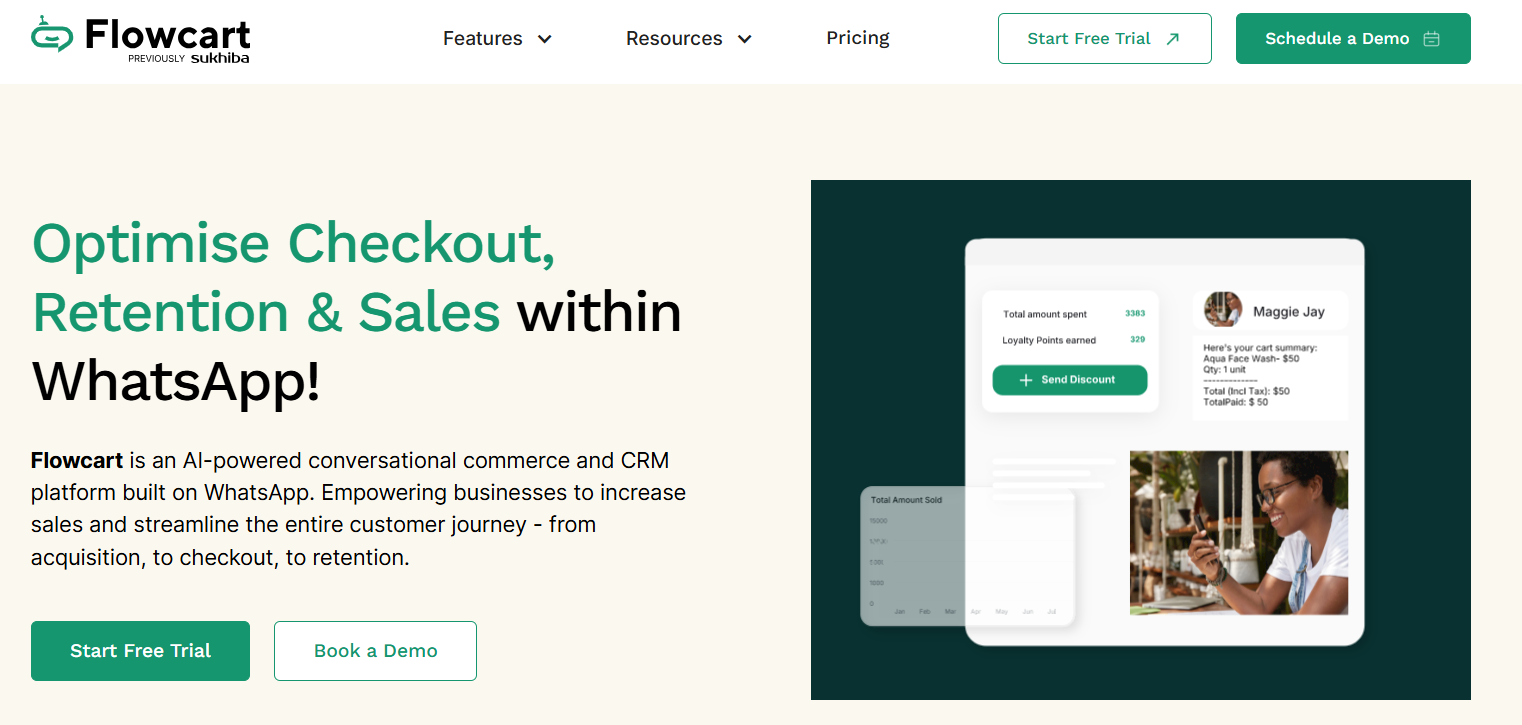
via Flowcart
Flowcart treats WhatsApp as a platform to complete the job: capture interest, qualify intent, and close within the same chat. The platform stitches together Click-to-WhatsApp entry points, conversational flows, AI replies, and one-tap carts so a conversation becomes a purchase without detours.
The neatest thing about Flowcart is how unshowy it is about the plumbing: campaign context, customer tags, and conversion events are all tracked and pushed to your stack, so marketing learns fast and sales never chase blind leads. If your brief is “make ads spend smarter and stop losing clicks,” Flowcart is built to do that work reliably.
If your next step is figuring out what this looks like for your team, check out Flowcart’s pricing. It’s the quickest way to understand how automation, in-chat checkout, and smarter campaigns fit within your current budget.
2. Interakt (Practical Inbox + No-Code Automation)

via Interakt
Interakt is the workhorse for teams that want WhatsApp to run like a support and sales desk, without a developer on speed dial. Its shared inbox and no-code workflow builder make it easy to route conversations, automate common replies, and add basic qualification into every chat.
It’s the kind of tool you hand to a lean operations team: straightforward, predictable, and focused on keeping conversations tidy and actionable.
Where Interakt shines is in day-to-day operations: enabling teams to collaborate on WhatsApp without complicated integrations, which makes it a sensible, low-friction choice for small and mid-market businesses.
3. Gallabox (Omnichannel CRM with Deep Integrations)

via Gallabox
Gallabox is like a CRM-first play that treats WhatsApp as the most interesting contact point. The strength here is the connective tissue: conversations, contact records, and third-party systems live in the same view, so handoffs and history don’t disappear into inbox limbo.
It’s a platform for teams that need context-rich pipelines, native CRM syncs, multi-channel routing, and broader ecosystem support to make it feel enterprise-ready.
If your core need is unified customer records and cross-tool visibility, Gallabox provides the scaffolding. However, if you also want to complete sales directly inside WhatsApp, Gallabox alone isn’t enough. You’d need to add another tool or integration that handles those commerce-specific actions inside chat.
4. AiSensy (AI-First Chatbots and Rich Media Conversations)
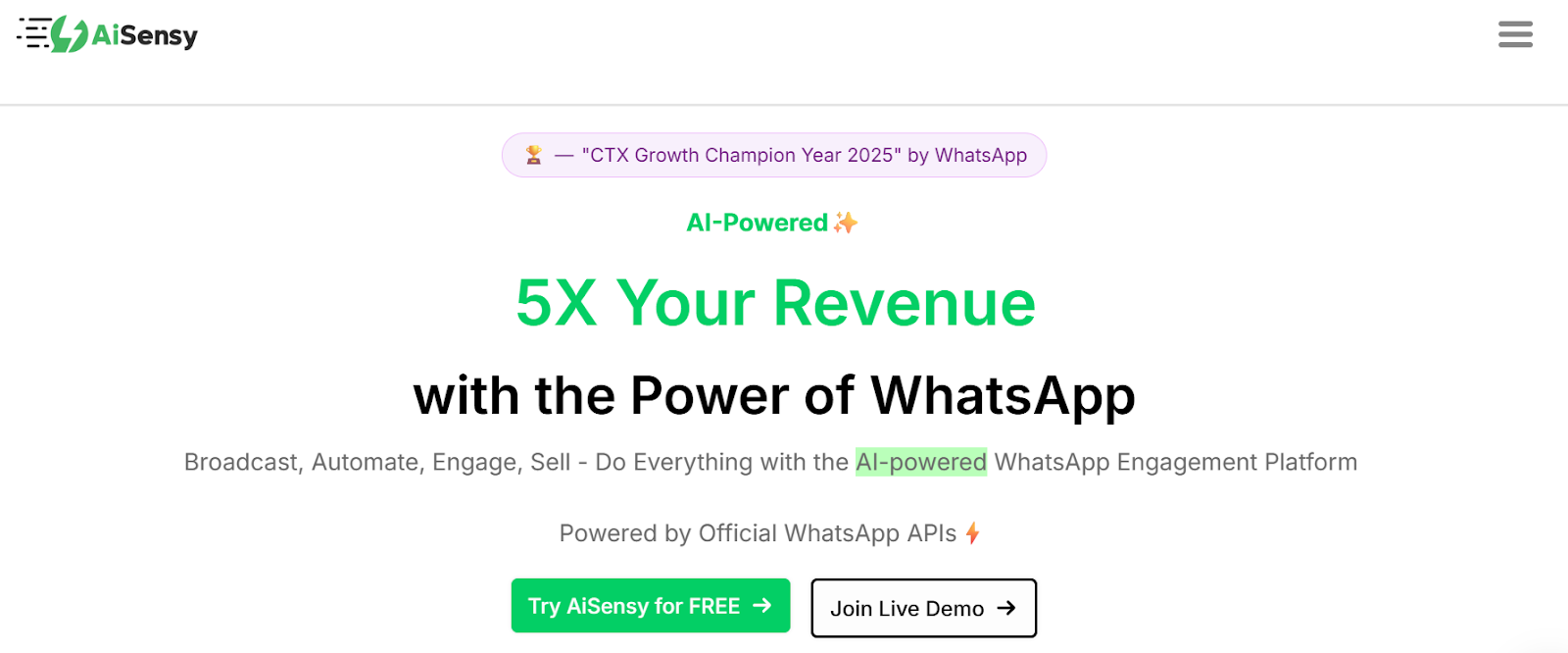
via AiSensy
AiSensy leans into the conversational possibilities: voice notes that convert to text, image-triggered replies, even AI-generated video responses. It’s built for teams that want their bots to behave like assistants, especially where multilingual support and rich media are important.
The platform makes ad-to-chat flows easy and gives marketers numerous creative levers to nudge prospects into conversation. It’s a smart fit when your priority is sophisticated conversational UX.
Which WhatsApp Lead Generation Software Is Right for You?
Choose Flowcart if you want WhatsApp to do the selling for you. It’s built for eCommerce and D2C teams who care about turning clicks into checkouts.
Choose Interakt if you need a simple and reliable setup for managing leads and chats without the technical overhead. Ideal for small teams that value clarity and control over complexity.
Choose Gallabox if your business already runs on CRM workflows and you want every WhatsApp conversation logged, synced, and visible across teams. Perfect for service-led or B2B companies.
Choose AiSensy if you’re experimenting with advanced chat automation and want your brand to sound human, at scale.
How to get started with WhatsApp lead generation with Flowcart?
Flowcart helps you build a system that turns ad clicks into customers in one continuous flow. Here’s how to set up WhatsApp conversational marketing for lead generation in Flowcart step by step.
Technique 1: Start with Click-to-WhatsApp Ads
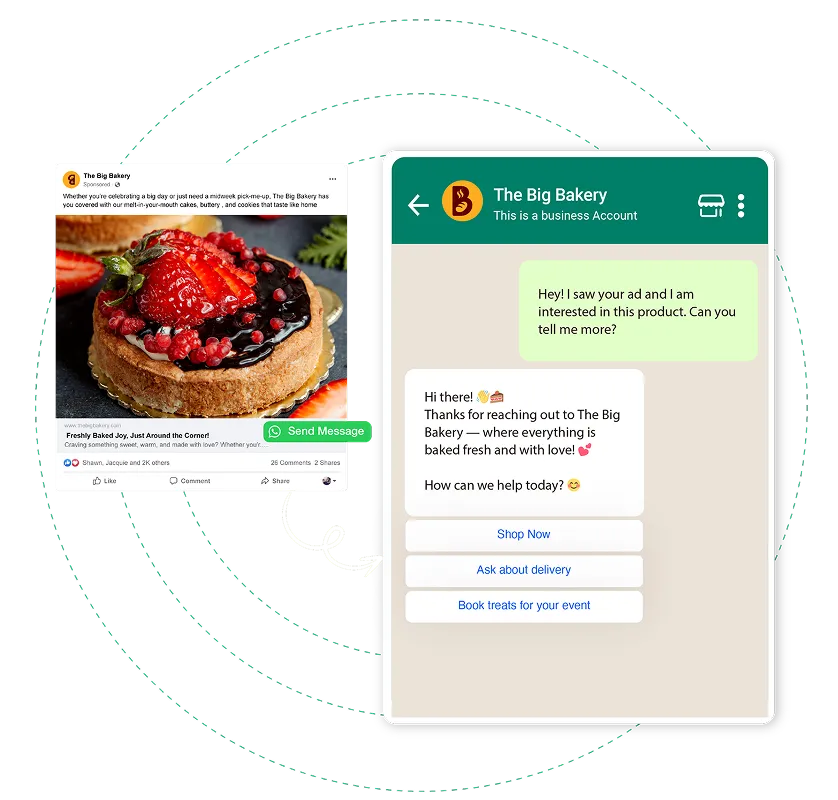
Connect your Meta Ad Account to Flowcart and launch Click-to-WhatsApp campaigns that open into a chat interface. Each ad click flows straight into WhatsApp, where Flowcart auto-detects the campaign, personalizes the opening message, and loads the right product offer.
Related Read: Powerful Benefits of WhatsApp Marketing Every Business Should Know
Technique 2: Build Interactive WhatsApp Flows
Once a lead starts chatting, Flowcart takes over. You can design conversational journeys that feel natural but promote your service using WhatsApp Flows:
- Drop AI-generated carts tailored to what the user wants.
- Enable in-chat payments to remove checkout drop-offs.
- Recover abandoned carts with timely nudges and personalized discounts.
- Keep loyal customers close with automated rewards and early-access offers.
Every step happens inside WhatsApp, so you’re never redirecting intent elsewhere.
Technique 3: Segment and Broadcast with Precision

Flowcart’s AI segmentation feature classifies every contact by behavior, engagement, and purchase patterns, allowing you to send smart, targeted broadcasts that read like one-on-one messages. Whether it’s a new collection drop, a restock alert, or a loyalty reminder, every message lands in context and with measurable results.
Case in Point: How Electromart Turned WhatsApp Into a Storefront
Electromart, a consumer electronics retailer operating across Ghana, Kenya, and Nigeria, used Flowcart to move beyond chat-based support and build a shopping journey inside WhatsApp.
Instead of static inquiries like “Do you have this model?”, Flowcart’s guided shopping assistant lets Electromart’s customers search for products, get personalized recommendations, browse visuals and prices, and even check out with cash-on-delivery in the chat.
This shift turned WhatsApp into a revenue channel for the brand. The results were astounding:
- Increased engagement
- Lengthened chat durations
- 100+ WhatsApp orders within the first 30 days
Electromart now plans to extend this experience with post-purchase automation and loyalty rewards using Flowcart, reinforcing what segmentation and personalization can achieve when the sales funnel lives entirely inside WhatsApp.
Explore this and more Flowcart customer stories here!
Technique 4: Bridge Offline and Online with QR Codes
Bring the same conversational journey to your physical touchpoints. Flowcart’s QR codes connect offline traffic to your online sales funnel, meaning you can add them on packaging, billboards, or pop-up stores, directly.
To sum it up, Flowcart turns WhatsApp from a messaging app into a self-learning sales ecosystem, where every chat is a potential transaction, and every customer feels seen.
If you’re curious to see how it would look for your business, book a personalized demo with the Flowcart team. They’ll help you map your first flow through live examples of how top brands are using conversational journeys to turn ad spend into repeat revenue.
FAQs
Do I need the WhatsApp Business API to run automated lead generation?
Yes, the WhatsApp Business API is required for large-scale, automated lead generation. It enables features like chatbots, message templates, CRM integrations, and automation workflows that aren’t available in the regular Business app. Without it, you’re limited to manual conversations and basic responses.
What is a WhatsApp journey builder?
A WhatsApp Journey Builder is a tool that helps businesses design automated, step-by-step customer interactions inside chat. You can visually map how a lead moves from the first message to qualification, follow-up, and conversion, without needing to code or manually reply.
How does WhatsApp journey builder create personalized lead nurturing sequences?
WhatsApp journey builder uses conditional logic and audience data to tailor each message based on user behavior, preferences, or responses. For example, if someone clicks “Learn more,” they receive product details; if they choose “Pricing,” they’re guided toward booking a demo. Every sequence automatically adapts to the customer’s intent.
How do automated journey builders prevent ‘chat fatigue’ during lead qualification?
Automated journey builders balance automation with pacing and context. Instead of spamming messages, they space out follow-ups, add interactive elements like buttons or quick replies, and trigger replies only when users engage. This keeps the experience conversational rather than overwhelming.
How does effective WhatsApp lead management help me qualify and prioritize leads?
Strong lead management systems automatically tag, score, and segment leads based on activity, like how quickly they respond or what they inquire about. This helps teams focus on high-intent prospects first, manage follow-ups, and maintain organized visibility across all active opportunities.
.png)

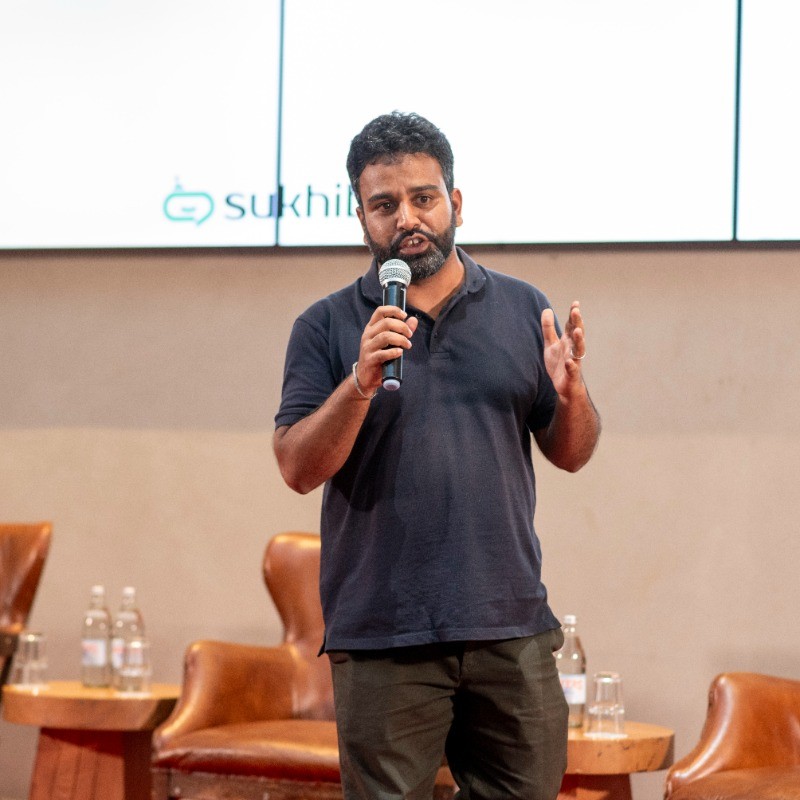
.png)
.png)


%201.webp)

